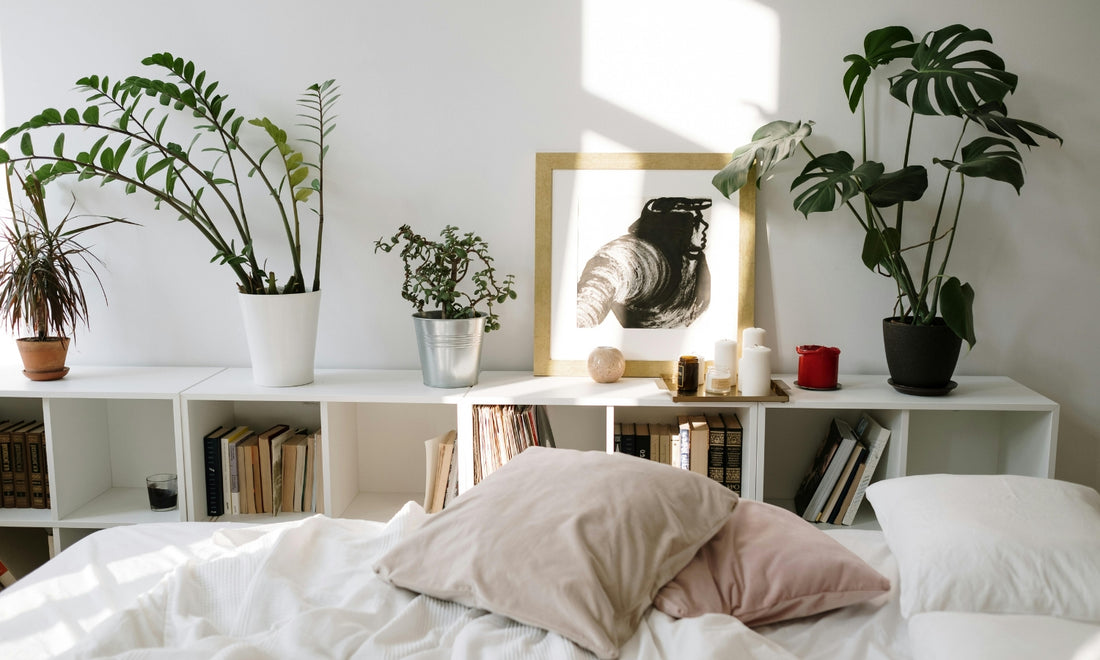
Bedroom decoration: the ideal plants for better sleep
Decorating your bedroom isn't just about choosing stylish furniture, calming colors, or decorative wall posters . Incorporating plants into your sleep space can transform the ambiance of your bedroom while improving the quality of your sleep. Learn how certain plants can purify the air , reduce stress, and promote better sleep .
The benefits of plants in the bedroom
Before diving into specific plants , it's essential to understand why plants can be beneficial in a bedroom.
Air purification
Many houseplants are known for their abilities to filter toxins from the air, improving the air quality in your room. These toxins include common substances like formaldehyde, benzene and trichlorethylene, often found in furniture, paints and cleaning products.
- Formaldehyde : Emitted by pressed wood products and certain textiles, it can irritate the eyes, nose and throat.
- Benzene : Found in plastics, resins, and synthetic fibers, it can cause headaches and dizziness.
- Trichlorethylene : Used in industrial solvents and dry cleaning products, it is potentially carcinogenic.
Plants like English ivy, Areca palm, and Boston fern are particularly effective at removing these toxins, contributing to a healthier, purer indoor environment.
Stress reduction
Having plants in your bedroom can reduce stress and anxiety, helping to create a calm and serene environment. Studies show that interactions with plants, even as simple as looking at them, can lower levels of the stress hormone cortisol.
- Lower blood pressure : Herbs can help reduce blood pressure, thereby promoting relaxation.
- Mood Improvement : Contact with nature and plants can increase levels of serotonin, the happy hormone.
- Natural aromatherapy : Certain plants like lavender and jasmine emit calming aromas that can help reduce anxiety and promote restful sleep.
By placing plants such as philodendron, lavender or chamomile in your bedroom, you can create an oasis of tranquility that encourages relaxation and mental well-being.
Increased humidity
Some plants increase humidity in the air, which can benefit your skin and respiratory tract. Plants increase humidity through a process called transpiration, where they release water vapor through their leaves.
- Skin Benefits : Increased humidity can help prevent dry skin and skin irritation.
- Easier breathing : More humid air can soothe the mucous membranes of the airways, reducing the likelihood of sore throats and nasal irritations.
- Plant Health : Proper humidity levels can also prevent the growth of certain allergens and airborne particles.
Plants like ficus, Boston fern, and Areca palm are particularly effective at increasing indoor humidity, thereby improving air quality and promoting a more comfortable sleeping environment.
Improved general well-being
Just seeing green plants can improve your mood and overall well-being. The presence of plants creates a connection with nature, bringing a feeling of peace and contentment.
- Increased Productivity : Plants can increase focus and productivity, even in a sleep space where you might also work or study.
- Enhanced Creativity : Nature and plants can boost creativity and innovation, helping you feel more inspired.
- Reduced Fatigue : The presence of plants can also help reduce mental and physical fatigue, leaving you feeling more energetic and revitalized.
The ideal plants for better quality of sleep
Here are some of the best plants to incorporate into your bedroom to promote restful sleep.
Lavender
Lavender is known for its soothing and relaxing properties. Its mild scent may help reduce anxiety and induce sleep. Place a small pot of lavender near your bed to benefit from its benefits.
Aloe Vera
Aloe vera is an easy-to-care-for plant that purifies the air by eliminating toxins. It also releases oxygen at night, which can improve air quality and promote deep sleep.
Jasmine
Jasmine has a calming effect on the body and mind. Its white flowers and delicate scent can reduce anxiety and promote better quality sleep. A small pot of jasmine on your bedside table can work wonders.
Mother-in-law's tongue (Sansevieria)
Mother-in-law's tongue , also known as the snake plant , is one of the best plants for purifying the air. It releases oxygen at night and eliminates toxins like formaldehyde and benzene. It is a robust plant that requires little maintenance.
Pothos
Pothos is a climbing plant that is also excellent for purifying the air. It is easy to maintain and can be placed high, creating a beautiful visual effect while improving air quality.
Tips for Incorporating Plants into Your Bedroom
Incorporating plants into your bedroom decor doesn't have to be complicated. Here are some tips to help you get started:
- Choose suitable pots : Opt for pots that match the style of your room. Pots made of ceramic, terracotta or natural materials can add a touch of elegance.
- Strategic location : Place plants where they can receive enough light without being directly exposed to drafts. Window sills, bedside tables and wall shelves are good choices.
- Vary heights and textures : Create visual interest by using plants of different heights and textures. Combine large-leaved plants with climbing plants or small succulents.
- Maintain Regularly : Make sure you take care of your plants by watering them regularly and pruning them if necessary. A healthy plant will be more effective in purifying the air and creating a calming atmosphere.
Conclusion
Incorporating plants into your bedroom decor is a great way to create a calming, sleep-friendly space. Plants like lavender , aloe vera , jasmine , snake plant , and pothos can not only beautify your bedroom but also improve your sleep quality by purifying the air and reducing stress. Try adding a few of these plants to your bedroom and enjoy the benefits they bring to your resting space.
By following these tips, you can transform your bedroom into a true sanctuary of tranquility, conducive to restful sleep and overall well-being.
Artistically yours, the ART HOMY team,
